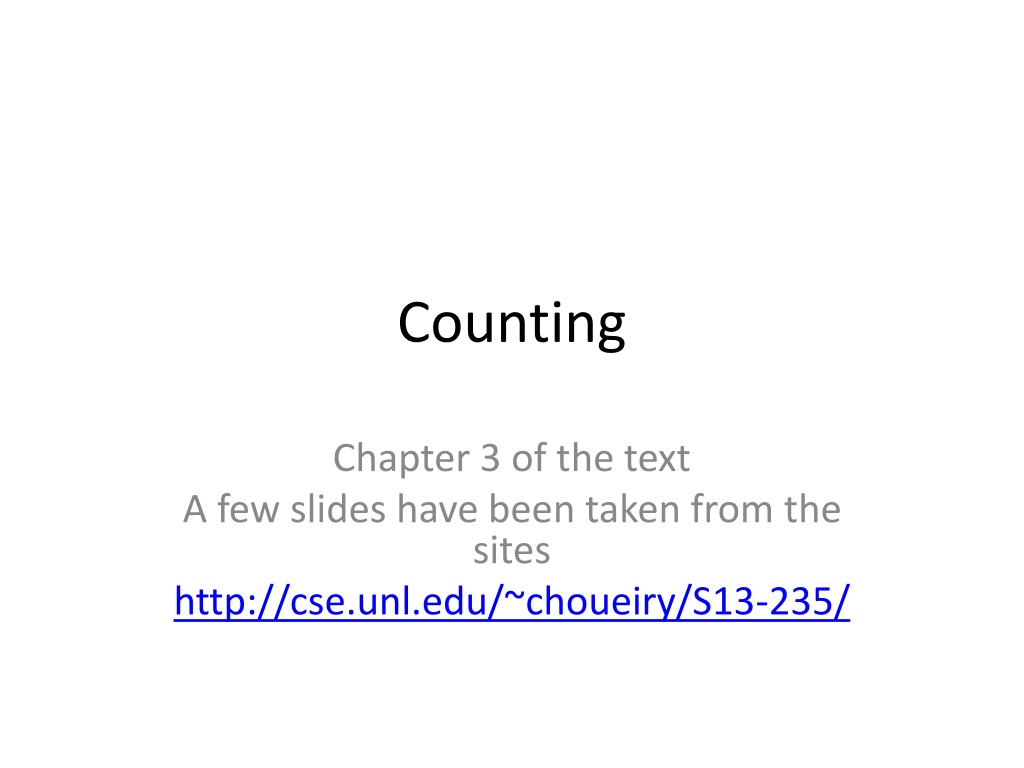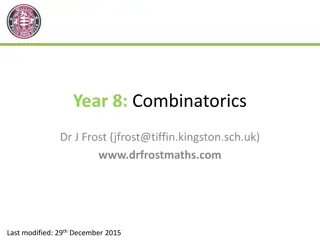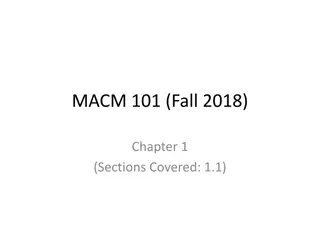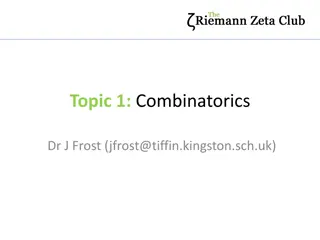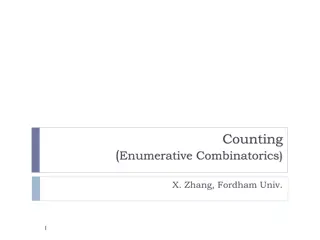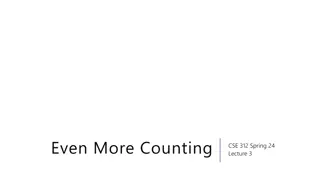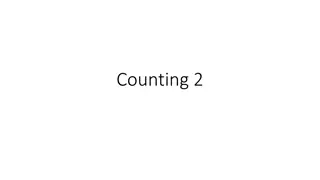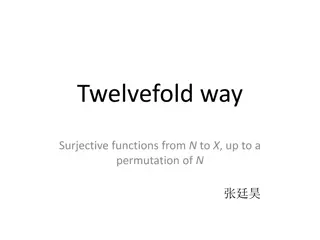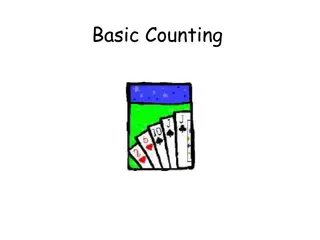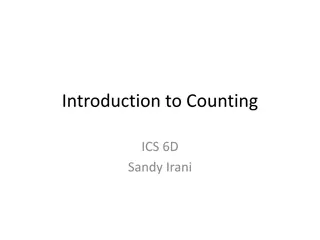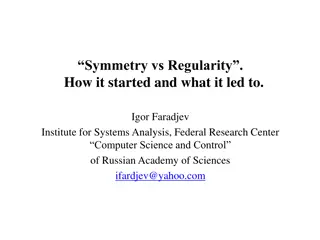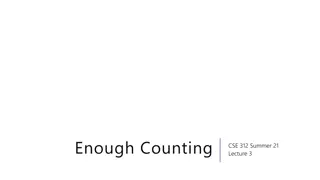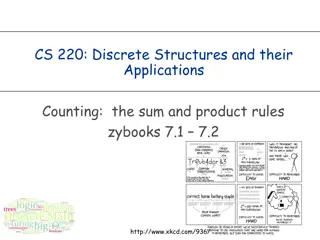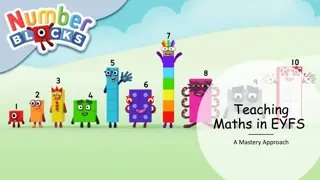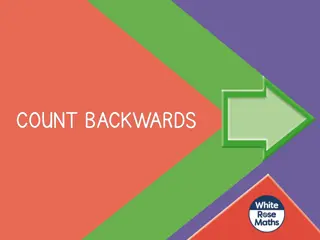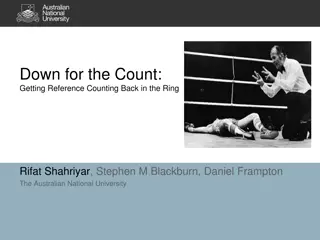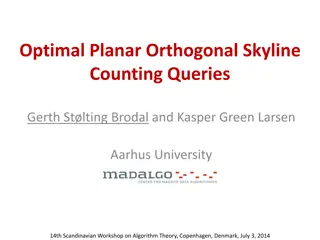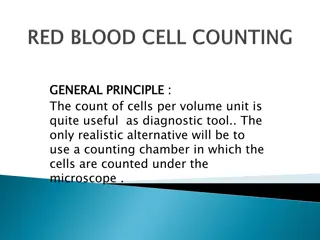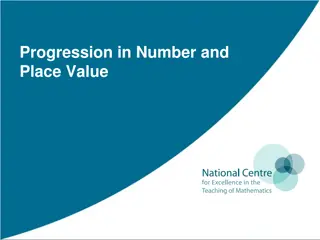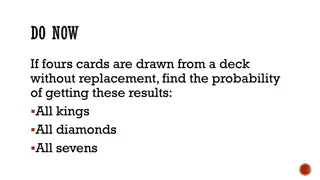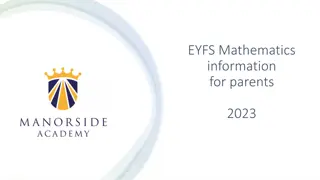Understanding Combinatorics and Counting in Mathematics
An exploration into combinatorics, focusing on arranging objects and counting possibilities. From dividing polygons to listing objects, delve into the world of counting and arrangement. Learn how counting plays a vital role in algorithms and probability, and discover the complexity it adds to various mathematical scenarios.
Download Presentation

Please find below an Image/Link to download the presentation.
The content on the website is provided AS IS for your information and personal use only. It may not be sold, licensed, or shared on other websites without obtaining consent from the author. Download presentation by click this link. If you encounter any issues during the download, it is possible that the publisher has removed the file from their server.
E N D
Presentation Transcript
Counting Chapter 3 of the text A few slides have been taken from the sites http://cse.unl.edu/~choueiry/S13-235/
Combinatorics Combinatorics is the study of arrangement of objects. For example: In how many ways can a convex polygon with n sides be divided into triangles by adding non- crossing diagonals? For n=3, there is only one.
Combinatorics For n=4, there are 2 such arrangements.
Combinatorics For n=5, there are 5 such arrangements.
Combinatorics For n=6, there are 14 such arrangements.
Combinatorics For n=7, there are 42 such arrangements.
Combinatorics Combinatorics is the study of arrangement of objects. Counting of objects with certain properties is an important component of combinatorics. We use counting to determine the complexity (running time) of algorithms. Counting plays important role in determining probabilities of events.
Counting In the class, the topic will be covered along the following lines. First go through Chapter 3 of the text. Next we will cover the materials of Chapter 6 of the book by Rosen. We will only cover the parts of this chapter not covered in the text.
Counting Lists (Section 3.1) A list is an ordered sequence of objects. Top 10 movies: A list of 10 movies which can be represented as (name 1, name 2, , name 10). The objects are ordered. ithelement of the list is the ithobject. (a,b) list different than (b,a). The number of elements in the list is called its length. Note the similarity with n-tuple we discussed earlier.
Counting Lists (Section 3.1) Consider two sets: A = MACM 101 students in the class; |A| = # of students G = Set of possible grades ; |G| is the # of grades. Consider a list with two objects: (name, grade) where the first object is name, an element of A, and the second object is grade, an element of G. How many possible different 2-tuples are possible? Note that it is nothing but the size of A x G.
Counting Lists (2) Suppose we want to make a list of length three having the property that the first entry must be an element of the set A = {a,b,c}, the second entry must be in B= {5,7} and the third entry must be in C={a,x}. How many such lists altogether? Again it is |A x B x C|. How do we generate these lists systematically?
Counting Lists Constructing lists of length three:
Multiplication Principle In making a list of length n, suppose there are a1possible choices for first entry, a2possible choices for the second entry, a3possible choices for the third entry, and so on. Then the total number of different lists that can be made is the product a1x a2x a3x . x an.
Example In BC, the license plate of a car has either three letters followed by three digits, or 3 digits followed by three letters. For example ABC007, 007ABC are two standard license plates. How many different license plates are possible? Note that any license plates such as ABC007 corresponds to a length-6 list (A, B, C, 0, 0, 7). # of license plates of the type (letter,letter,letter, digit,digit,digit) is 26 x 26 x 26 x 10 x 10 x 10
Example In BC, the license plate of a car has either three letters followed by three digits, or 3 digits followed by three letters. For example ABC007, 007ABC are two standard license plates. How many different license plates are possible? Note that any license plates such as ABC007 corresponds to a length-6 list (A, B, C, 0, 0, 7). # of license plates of the type (letter,letter,letter, digit,digit,digit) is 26 x 26 x 26 x 10 x 10 x 10 # of license plates of the type (digit,digit,digit,letter,letter,letter) is 10 x 10 x 10 x 26 x 26 x 26
Example In BC, the license plate of a car has either three letters followed by three digits, or 3 digits followed by three letters. For example ABC007, 007ABC are two standard license plates. How many different license plates are possible? Note that any license plates such as ABC007 corresponds to a length-6 list (A, B, C, 0, 0, 7). # of license plates of the type (letter,letter,letter, digit,digit,digit) is 26 x 26 x 26 x 10 x 10 x 10 # of license plates of the type (digit,digit,digit,letter,letter,letter) is 10 x 10 x 10 x 26 x 26 x 26 Total = 2 x 26 x 26 x 26 x 10 x 10 x 10
Example Consider making lists from the symbols A, B, C, D, E, F, G (a) How many length-4 lists are possible if repetition is allowed (i.e. a symbol may appear more than once)? (b) How many length-4 lists are possible if repetition is not allowed? (c) How many length-4 lists are possible if repetition is not allowed and the list must contain an E? (d) How many length-4 lists are possible if repetition is allowed and the list must contain an E?
Example Consider making lists from the symbols A, B, C, D, E, F, G (a) How many length-4 lists are possible if repetition is allowed (i.e. a symbol may appear more than once)? Ans:
Example Consider making lists from the symbols A, B, C, D, E, F, G (a) How many length-4 lists are possible if repetition is allowed (i.e. a symbol may appear more than once)? Ans: There are 7 choices for each position of the list. Therefore, the number of length-4 lists in this case is 7 x 7 x 7 x 7.
Example Consider making lists from the symbols A, B, C, D, E, F, G (b) How many length-4 lists are possible if repetition is not allowed? Ans
Example Consider making lists from the symbols A, B, C, D, E, F, G (b) How many length-4 lists are possible if repetition is not allowed? Ans Here repetition is not allowed. Note that once the letter for position one of the list is chosen, the same letter cannot be chosen again. Thus the choice for the first position is 7, and the choice for the second position is 6. Once the second position of the list is filled, there only 5 choices for the third position of the list. Therefore, the total number length-4 lists is 7 x 6 x 5 x 4
Example Consider making lists from the symbols A, B, C, D, E, F, G (c) How many length-4 lists are possible if repetition is not allowed and the list must contain an E? Ans:
Example Consider making lists from the symbols A, B, C, D, E, F, G (c) How many length-4 lists are possible if repetition is not allowed and the list must contain an E? Ans: There are four types of lists depending on whether E occurs as the first, second, third or fourth entry. These four types are shown below.
Example Consider making lists from the symbols A, B, C, D, E, F, G (c) How many length-4 lists are possible if repetition is not allowed and the list must contain an E? Ans: There are four types of lists depending on whether E occurs as the first, second, third or fourth entry. These four types are shown below. Total # =(6 x 5 x 4) + (6 x 5 x 4) + (6 x 5 x 4) + (6 x 5 x 4)
Example Consider making lists from the symbols A, B, C, D, E, F, G (d) How many length-4 lists are possible if repetition is allowed and the list must contain an E? Ans:
Example Consider making lists from the symbols A, B, C, D, E, F, G (d) How many length-4 lists are possible if repetition is allowed and the list must contain an E? Ans: Again there are four types of lists.
Example Consider making lists from the symbols A, B, C, D, E, F, G (d) How many length-4 lists are possible if repetition is allowed and the list must contain an E? Ans: Again there are four types of lists. The total number of lists is 4 x 74= 1372.
Example Consider making lists from the symbols A, B, C, D, E, F, G (d) How many length-4 lists are possible if repetition is allowed and the list must contain an E? Ans: Again there are four types of lists. The total number of lists is 4 x 74= 1372 which is substantially larger than the correct value of 1105.
Example Consider making lists from the symbols A, B, C, D, E, F, G (d) How many length-4 lists are possible if repetition is allowed and the list must contain an E? Ans: Again there are four types of lists. The total number of lists is 4 x 74= 1372 which is substantially larger than the correct value of 1105. Note: The list (E,A,E,C,D) is counted twice, one as a type 1 and one as a type 3. Similarly (E,E,E,E) is counted 4 times.
Example Consider making lists from the symbols A, B, C, D, E, F, G (d) How many length-4 lists are possible if repetition is allowed and the list must contain an E? Ans: Again there are four types of lists. Need to think it differently The total number of lists is 4 x 74= 1372 which is substantially larger than the correct value of 1105. Note: The list (E,A,E,C,D) is counted twice, one as a type 1 and one as a type 3. Similarly (E,E,E,E) is counted 4 times.
Example Consider making lists from the symbols A, B, C, D, E, F, G (d) How many length-4 lists are possible if repetition is allowed and the list must contain an E? Ans: Correct thinking:
Example Consider making lists from the symbols A, B, C, D, E, F, G (d) How many length-4 lists are possible if repetition is allowed and the list must contain an E? Ans: Correct thinking: (a) We know that the number of length-4 lists with repetitions is 74.
Example Consider making lists from the symbols A, B, C, D, E, F, G (d) How many length-4 lists are possible if repetition is allowed and the list must contain an E? Ans: Correct thinking: (a) We know that the number of length-4 lists with repetitions is 74. (b) There are many lists which contain no E. We subtract these lists (containing no E) from 74 to obtain the number of lists that contain at least one E. There are 64 lists that do not have an E.
Example Consider making lists from the symbols A, B, C, D, E, F, G (d) How many length-4 lists are possible if repetition is allowed and the list must contain an E? Ans: Correct thinking: (a) We know that the number of length-4 lists with repetitions is 74. (b) There are many lists which contain no E. We subtract these lists (containing no E) from 74 to obtain the number of lists that contain at least one E. There are 64 lists that do not have an E. (c) Therefore there are 74 64 = 1105 lists with repetition allowed that contain at least one E.
Example Consider making lists from the symbols A, B, C, D, E, F, G (d) How many length-4 lists are possible if repetition is allowed and the list must contain an E? Ans: Correct thinking: (a) We know that the number of length-4 lists with repetitions is 74. (b) There are many lists which contain no E. We subtract these lists (containing no E) from 74 to obtain the number of lists that contain at least one E. There are 64 lists that do not have an E. (c) Therefore there are 74 64 = 1105 lists with repetition allowed that contain at least one E. In solving counting problems, we must always be careful to avoid this kind of multiple counting.
Examples from text 3.1(4) Five cards are dealt off of a standard 52-card deck and lined up in a row. How many such line ups are there in which all 5 cards are of the same suit? Ans:
Examples from text 3.1(4) Five cards are dealt off of a standard 52-card deck and lined up in a row. How many such line ups are there in which all 5 cards are of the same suit? Ans: There are 4 suites: club, diamond, heart and spade. Each suite has 13 cards. how many rows (lists) of 5-card club suite?
Examples from text 3.1(4) Five cards are dealt off of a standard 52-card deck and lined up in a row. How many such line ups are there in which all 5 cards are of the same suit? Ans: There are 4 suites: club, diamond, heart and spade. Each suite has 13 cards. how many rows (lists) of 5-card club suite? first element has 13 choices second element has 12 choices third element has 11 choices fourth element has 10 choices fifth element has 9 choices.
Examples from text 3.1(4) Five cards are dealt off of a standard 52-card deck and lined up in a row. How many such line ups are there in which all 5 cards are of the same suit? Ans: There are 4 suites: club, diamond, heart and spade. Each suite has 13 cards. how many rows (lists) of 5-card club suite? first element has 13 choices second element has 12 choices third element has 11 choices fourth element has 10 choices fifth element has 9 choices. number of 5-card lists of club suites = 13.12.11.10.9 number of 5-card lists of four suites= 4.13.12.11.10.9
Examples from text 3.1(10) This problem concerns list made from the letters A, B, C, D, E, F, G, H, I, J. (a) How many length-5 lists can be made from these letters if repetition is not allowed, and the list must begin with a vowel? (b) How many length-5 lists can be made from these letters if repetition is not allowed, and the list must begin and end with a vowel? (c) How many length-5 lists can be made from these letters if repetition is not allowed, and the list must contain exactly one A.
Examples from text 3.1(10) This problem concerns list made from the letters A, B, C, D, E, F, G, H, I, J. (a) How many length-5 lists can be made from these letters if repetition is not allowed, and the list must begin with a vowel? Ans: There are 3 vowels in the given letters: A, E and I.
Examples from text 3.1(10) This problem concerns list made from the letters A, B, C, D, E, F, G, H, I, J. (a) How many length-5 lists can be made from these letters if repetition is not allowed, and the list must begin with a vowel? Ans: There are 3 vowels in the given letters: A, E and I. There are three types of lists we need to count. One type that starts with A, the other two types that start with E and I. Lists that start with A: Since no repetition is allowed, there are 9 choices for position 2, 8 choices for position 3, 7 choices for position 4 and 6 choices for position 5. Total number of lists for this type: 9.8.7.6 Total number of lists of all types: 3x(9.8.7.6)
Examples from text 3.1(10) This problem concerns list made from the letters A, B, C, D, E, F, G, H, I, J. (b) How many length-5 lists can be made from these letters if repetition is not allowed, and the list must begin and end with a vowel?
Examples from text 3.1(10) This problem concerns list made from the letters A, B, C, D, E, F, G, H, I, J. (b) How many length-5 lists can be made from these letters if repetition is not allowed, and the list must begin and end with a vowel? Ans: There are six types lists: one starts with A and ends with E.; one starts with A and ends in I; one starts with E and ends with A; one starts with E and ends with I; one starts with I and ends with A; and one starts with I and ends with E. Lists that starts with A and ends in E: the choices for positions 2, 3, 4 are 8, 7, 6 respectively. Total such lists is 8.7.6. Total number of lists of all types is 6x(8.7.6) Note that 6 types of lists come from the fact there are 3 vowels enumerating lists with 2 positions.
Examples from text 3.1(10) This problem concerns list made from the letters A, B, C, D, E, F, G, H, I, J. (c) How many length-5 lists can be made from these letters if repetition is not allowed, and the list must contain exactly one A. Very similar to a problem solved earlier.
Factorial (section 3.2) For any positive integer n, n! means: n(n-1)(n-2) . 3.2.1 0! is defined as equal to one. Examples: 4! = 4.3.2.1 = 24. Examples: 3.5! = 3.(5!)
Example Consider the problem of counting lists of length seven from the symbols 0, 1, 2, 3, 4, 5, 6. (a) How many such lists if repetition is not allowed Ans: 7.6.5.4.3.2.1
Example Consider the problem of counting lists of length seven from the symbols 0, 1, 2, 3, 4, 5, 6. (a) How many such lists if repetition is not allowed Ans: 7.6.5.4.3.2.1 which is 7!.
Example Consider the problem of counting lists of length seven from the symbols 0, 1, 2, 3, 4, 5, 6. (a) How many such lists if repetition is not allowed Ans: 7.6.5.4.3.2.1 which is 7!. (b) How many such lists if repetition is not allowed, and the first three entries must be odd.
Example Consider the problem of counting lists of length seven from the symbols 0, 1, 2, 3, 4, 5, 6. (a) How many such lists if repetition is not allowed Ans: 7.6.5.4.3.2.1 which is 7!. (b) How many such lists if repetition is not allowed, and the first three entries must be odd. There are three odd numbers in the seven symbols. We therefore fill first three positions with odd numbers and the last four positions with even numbers. Thus the total number is 3.2.1.4.3.2.1 which is 3!4!. Thus we note that there 3! ways to form length-3 lists and 4! ways to form length-4 lists.
